Occupational Environment Monitoring at Induction Stove Manufacturing Factory
99,000 ₫
Note: The above price is calculated for one sample, the price may vary depending on the area of the environment to be monitored and the fluctuations of the market. For more accurate price support, please refer to the quotation table or contact our consulting staff directly.
Environmental monitoring of the induction stove manufacturing factory is a session of collecting, analyzing, and evaluating workplace factors that may harm workers’ health.
Table of Contents
Toggle1. Overview of Induction Stove Manufacturing Factory
a. What is an induction stove manufacturing factory?
Manufacturing factory for induction stoves is a production facility specialized in manufacturing induction stoves. An induction stove is a type of stove that uses electromagnetic technology to generate heat for cooking. Instead of using heat from flames like a gas stove, an induction stove generates heat through a magnetic field created by electric coils when electricity passes through them. This creates a magnetic field that heats the pot or pan placed on the stove surface. Induction stove manufacturing factories typically produce and assemble components, electronic circuits, and parts to create complete induction stoves ready for the consumer market.

b. Production stages in an induction stove manufacturing factory
The production stages in an induction stove manufacturing factory may include:
- Frame and casing fabrication: This process involves cutting, bending, and welding metal components to create the frame and casing, ensuring the product’s durability and sturdiness.
- Electrical circuit assembly: The induction stove’s electrical circuit is assembled by installing electronic components, circuit boards, sensors, and controllers. This step is crucial to ensure the proper and safe operation of the stove.
- Stove surface installation: The induction stove surface is installed and connected to the circuit. It is typically made from heat-resistant materials such as tempered glass or ceramic, which provide good heat conduction and easy cleaning.
- Accessory assembly and testing: Accessories like knobs, control panels, wires, and sockets are assembled and tested for functionality.
- Quality and performance testing: After assembly, induction stoves undergo quality and performance testing to ensure they operate correctly and meet quality standards.
- Packing and shipping: Finally, induction stoves are packed ready for transport and export. The packing process ensures the product is protected and not damaged during transportation.

c. Types of machinery used in an induction stove manufacturing factory
In an induction stove manufacturing factory, several types of machinery are commonly used in the production process. Some common machines include:
- Metal cutting and bending machines: Used to cut and bend metal components such as steel tubes, metal sheets, and wires to create the stove frame and casing.
- Welding machines: Used to weld metal components together, ensuring product strength and durability.
- Circuit assembly machines: Used to assemble electronic components, circuit boards, sensors, and controllers to form the stove’s electrical circuit.
- Surface cutting and processing machines: Used to cut and process the stove surface, such as cutting tempered glass or ceramic to the required size and shape.
- Knob and accessory assembly machines: Used to assemble and attach accessories like knobs, control panels, and other components to the stove surface.
- Quality and performance testing machines: Used to test the functions, performance, and safety of the induction stove before packing and shipping.

d. Occupational diseases for workers in induction stove manufacturing factories
Workers in induction stove manufacturing factories may encounter health issues and occupational diseases such as:
- Noise-related diseases: During production, machinery and processing may generate loud noise. Continuous exposure can cause hearing problems and stress for workers.
- Chemical-related diseases: Induction stove production may involve chemicals like solvents, cleaning agents, coatings, or anti-corrosion substances. Exposure to these chemicals without proper safety measures can cause skin irritation, respiratory issues, and potential long-term health effects.
- UV-related diseases: Ultraviolet light may be used for fast-drying coatings or insulating materials. Exposure without protection can cause skin burns, dermatitis, and eye damage.
- Ergonomic-related diseases: Work may require repetitive motions, heavy lifting, or prolonged awkward postures, leading to musculoskeletal injuries, headaches, back pain, and posture-related problems.
- Dust and air pollution-related diseases: Processing and machinery operation can generate dust and air pollution. Long-term exposure may cause pneumonia, difficulty breathing, and other respiratory issues.
To minimize occupational disease risks, induction stove manufacturing factories must implement safety and labor protection measures, including providing personal protective equipment, ensuring effective ventilation and smoke extraction, training staff on workplace safety, and managing environmental risks.

e. Common types of induction stoves on the market
Currently, there are several popular types of induction stoves used in homes and professional kitchens:
- Single induction stove: A basic induction stove with one cooking zone. It may include temperature and timer control features and can be operated via knobs or touchscreen.
- Double induction stove: This type has two independent cooking zones, allowing multiple dishes to be cooked simultaneously at different temperatures. Controlled via knobs or touchscreen.
- Multi-zone induction stove: Features three or more cooking zones, allowing multiple dishes to be cooked at once with varying temperatures and power. Zones can be controlled independently, with functions such as timers, warming features, and safety alerts.
- Induction stove with rapid heating: Equipped with fast heating features, enabling quick cooking and saving time. High temperature and power allow rapid cooking.
- Induction stove integrated with infrared: Some models include one or more infrared cooking zones. These zones provide high heat and fast cooking capabilities, saving time.
2. Overview of occupational environment monitoring services
a. What is occupational environment monitoring at an induction stove factory?
Occupational environment monitoring (or workplace environmental measurement) at an induction stove factory involves collecting, evaluating, and analyzing measurement indicators of workplace environmental factors. This aims to implement timely solutions, minimize environmental harm to workers’ health, and prevent occupational diseases. Occupational environment monitoring is mandatory for induction stove factories.
Occupational environment monitoring plays a crucial role in caring for, protecting, and improving workers’ health because employees are the main resource of a business and directly generate profit. Workers frequently exposed to hazardous factors above allowable limits can suffer health issues and occupational diseases.
REGISTER FOR OCCUPATIONAL ENVIRONMENT MONITORING SERVICE
b. Nam Viet occupational environment monitoring program
Nam Viet’s occupational environment monitoring program is developed by engineers specialized in occupational safety and environmental protection. To ensure workers’ health and safety, the program uses modern measurement methods to monitor air quality, water, microclimate factors, physical parameters, dust, etc., in the workplace. This program is vital for maintaining a safe working environment and protecting workers’ health.
Additionally, Nam Viet’s program plays an important role in researching and developing new solutions to improve workplace environmental quality. With the dedication and professionalism of monitoring experts, Nam Viet’s exclusive program represents a breakthrough in occupational safety management and environmental protection in Vietnam.

c. Standardization in occupational environment measurement procedures
Standardization in Nam Viet’s occupational environment measurement procedures is crucial for ensuring accurate results. To ensure precision and reliability, the program follows recognized standards and procedures from the Ho Chi Minh City Department of Health. This guarantees that collected data can be reliably used to evaluate workplace environment and make informed decisions to protect workers’ health.
These standardized procedures also ensure measurements are conducted by highly qualified monitoring specialists with years of experience, enabling managers and experts to trust Nam Viet’s results and make accurate, valuable decisions for protecting worker health and the environment.
By applying standardization in occupational environment measurement, Nam Viet demonstrates its commitment to ensuring a safe workplace and protecting workers’ health, while contributing positively to improving occupational safety management and environmental protection in Vietnam.
d. Reporting results of induction stove factory monitoring
Monitoring results are prepared according to Form 04, Appendix III issued with Decree 44/2016/ND-CP and made in two copies: one sent to the enterprise that contracted the monitoring service, and one kept by the organization performing the monitoring.
Monitoring results must be stored indefinitely according to legal regulations.

e. Frequency of occupational environment monitoring as required by law
According to Clause 2 of Article 18 of Labor Safety and Hygiene Law 84/2015/QH13, employers must conduct occupational environment monitoring to evaluate hazardous factors at least once a year.
f. Deadline for submitting occupational environment monitoring reports according to law
The deadline for report submission is before December 31 each year. Enterprises of production facilities must submit monitoring reports to the Department of Health in the locality where the business has its headquarters and where workers are employed.
When there are changes in technology or production processes, or when upgrading facilities that may introduce new hazards to workers’ health, enterprises must update their occupational hygiene records regarding hazardous factors that require monitoring.
g. Penalties for employers violating occupational environment monitoring regulations
According to Article 27 of Decree No. 12/2022/ND-CP dated 17/01/2022 on administrative penalties in labor, social insurance, and Vietnamese workers working abroad under contract:
- Clause 2: A fine of 2,000,000 – 5,000,000 VND for employers who fail to publicly announce monitoring results and hazard evaluations to employees at the workplace immediately after receiving the results.
- Clause 3: A fine of 20,000,000 – 40,000,000 VND for employers who fail to conduct occupational environment monitoring to control health risks to employees as required by law.
- Clause 4: A fine of 40,000,000 – 60,000,000 VND for employers who collude with monitoring organizations to commit fraud in monitoring activities but not reaching criminal liability.
3. Environmental factors harmful to workers in the induction stove manufacturing factory
In the induction stove manufacturing factory, there are several environmental factors that can harm workers. Below are some main factors:
- Noise: Machinery and equipment during the production of induction stoves can generate high levels of noise, especially when operating at full capacity. Continuous and loud noise can cause stress, fatigue, and affect workers’ health and concentration.
- Dust and chemical fumes: The processing and production of induction stoves can produce dust and chemical fumes from materials used. Dust and chemical fumes can irritate the respiratory tract, cause allergies, and other health problems for workers.
- Temperature and humidity: The working environment in the induction stove manufacturing factory may have high temperature and humidity due to the operation of machinery and equipment. A hot and humid environment can cause discomfort, fatigue, and affect workers’ performance.
- Lighting: Work areas in the induction stove manufacturing factory need adequate lighting so workers can perform tasks safely and efficiently. Insufficient or uneven lighting can cause eye strain, loss of concentration, and accidents.
- Electrical safety: During the production of induction stoves, workers come into contact with electrical equipment and systems. Electrical safety risks such as electrical faults, leakage, or electric shocks can endanger workers’ health and safety.
REGISTER FOR WORKPLACE ENVIRONMENT MONITORING SERVICE
4. Measures to improve the working environment in the induction stove manufacturing factory
To improve the working environment in the induction stove manufacturing factory and protect workers’ health, the following measures can be applied:
- Ensure a good ventilation system: Install an effective ventilation system to remove dust and chemical fumes during production, while ensuring a spacious and breathable working environment.
- Provide personal protective equipment: Ensure workers are equipped with full personal protective equipment such as masks, safety glasses, and gloves to protect them from harmful agents like dust, chemicals, and heat.
- Ensure adequate lighting: Provide sufficient and even lighting in work areas so workers can work safely and efficiently. Use appropriate lighting and regularly inspect and maintain it to ensure good condition.
- Adjust temperature and humidity: Ensure a comfortable working environment in terms of temperature and humidity. Use air conditioning or fans to regulate temperature and ensure comfort and ventilation for workers.
- Training and education: Train workers on occupational safety and health, provide guidance on proper use of personal protective equipment, and safe work procedures.
- Equipment inspection and maintenance: Conduct regular inspections and maintenance of machinery and equipment to ensure safe and efficient operation, avoiding unwanted hazards.
- Risk management: Assess and manage safety and health risks during induction stove production. Apply preventive and control measures to minimize the risk of injuries and health impacts for workers.
- Periodically conduct workplace environment monitoring in factories, collect and analyze harmful factors for workers, then adjust to reduce hazards and prevent occupational diseases.
5. Benefits of periodic monitoring of induction stove manufacturing factories
An Toan Nam Viet provides businesses with excellent benefits when using workplace environment monitoring services in accordance with Decree 44/2016/ND – CP regarding management and control of harmful factors in the working environment affecting employees.
- Businesses can proactively control harmful factors in their workshops or factories.
- Receive recommendations on measures to reduce harmful factors and improve working environment quality.
- Indirectly protect human resources, a key factor in business development.
- Reduce the impact of occupational diseases on human health, thereby lowering future treatment costs.
- Improved worker health leads to better product quality and maintained production output.
- Comply with occupational safety laws, avoiding legal risks.
- Enhance reputation and professionalism in all aspects, thereby elevating the business brand.
Nam Viet’s environmental monitoring service is a solution to minimize occupational disease impact, contributing to a clean and quality working environment.

6. National workplace environment monitoring center
Nam Viet Workplace Environment Monitoring Center is a professional unit in monitoring and measuring workplace environment quality across all provinces in Vietnam. With a team of experienced monitoring specialists, the center uses modern measuring equipment, ensuring accuracy and reliability.
In addition to providing monitoring services, the center also supports customers in planning, handling, and tracking workplace environment issues. With the motto “customer-centered,” the center focuses on customer satisfaction, meeting all customer needs, and commits to offering the best solutions for businesses.
REGISTER FOR WORKPLACE ENVIRONMENT MONITORING SERVICE
With investment in technology, equipment, and human resources, Nam Viet’s monitoring center has become one of the most reputable units in workplace environment monitoring in Ho Chi Minh City with the following objectives:
- We always value the brand reputation and quality of our services.
- We provide customers with the best and most suitable solutions possible.
- Along with a team of Masters and Engineers with experience and expertise, aiming to protect the environment and benefit businesses.
- With Nam Viet Environmental Monitoring Team, companies will receive professional service from monitoring experts, along with the best cost incentives.
The workplace environment monitoring process at Nam Viet includes the following basic steps:
- Before performing workplace environment monitoring, we ensure that all machines and equipment are calibrated and adjusted according to legal regulations.
- Follow the workplace environment monitoring procedures fully as committed to the Department of Health.
- Honestly report workplace environment monitoring results to the employer.
- If the monitoring results indicate unsafe conditions for workers, Nam Viet will support solutions, and the workplace will implement the following:
- Implement measures to improve working conditions to minimize harmful factors and prevent occupational diseases.
- Organize health check-ups to detect occupational and related diseases early for workers in unsafe work environments.
- Provide material compensation to workers according to labor laws.

7. Workplace environment monitoring pricing
To help businesses perform workplace environment monitoring professionally and effectively, Nam Viet provides customers with a workplace environment monitoring service price list that is high-quality and reasonably priced.
- Our price list provides detailed information about the costs of our monitoring services, including expenses for transportation, measurement, analysis, and reporting results. Customers can fully trust the accuracy and reliability of the monitoring reports we provide.
- We are committed to offering the most competitive and reasonable prices in the market, and we are always ready to provide prompt and professional consultation regarding monitoring services.
- With Nam Viet’s monitoring price list, customers can easily choose service packages that suit their needs. We are committed to delivering the highest customer satisfaction with professional service quality.
No comments yet

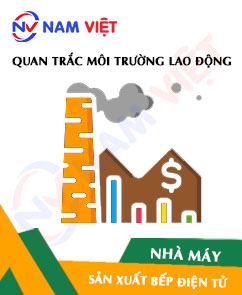
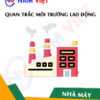
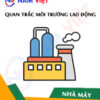
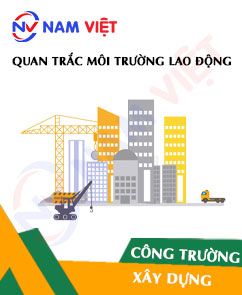



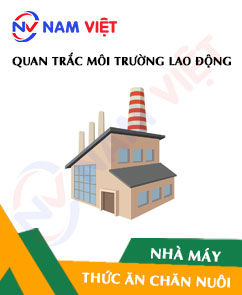

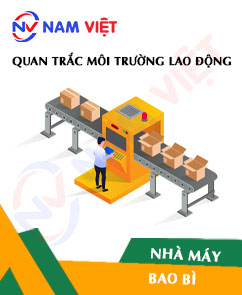

Review Occupational Environment Monitoring at Induction Stove Manufacturing Factory
There are no reviews yet.